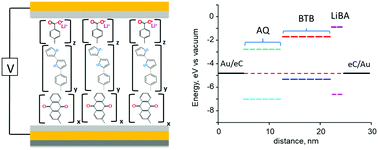当前位置:
X-MOL 学术
›
Nanoscale Horiz.
›
论文详情
Our official English website, www.x-mol.net, welcomes your
feedback! (Note: you will need to create a separate account there.)
Nanometric building blocks for robust multifunctional molecular junctions†
Nanoscale Horizons ( IF 8.0 ) Pub Date : 2017-09-20 00:00:00 , DOI: 10.1039/c7nh00109f David D. James 1, 2, 3 , Akhtar Bayat 1, 2, 3 , Scott R. Smith 1, 2, 3 , Jean-Christophe Lacroix 4, 5, 6, 7, 8 , Richard L. McCreery 1, 2, 3
Nanoscale Horizons ( IF 8.0 ) Pub Date : 2017-09-20 00:00:00 , DOI: 10.1039/c7nh00109f David D. James 1, 2, 3 , Akhtar Bayat 1, 2, 3 , Scott R. Smith 1, 2, 3 , Jean-Christophe Lacroix 4, 5, 6, 7, 8 , Richard L. McCreery 1, 2, 3
Affiliation

|
Much of the motivation for developing molecular electronic devices is the prospect of achieving novel electronic functions by varying molecular structure. We describe a “building block” approach for molecular junctions resulting in one, two or three nanometer-thick molecular layers in a commercially proven junction design. A single layer of anthraquinone between carbon electrodes provides a tunnel device with applications in electronic music, and a second layer of a thiophene derivative yields a molecular rectifier with quite different audio characteristics. A third layer of lithium benzoate produces a redox-active device with possible applications in non-volatile memory devices or on-chip energy storage. The building block approach forms a basis for “rational design” of electronic functions, in which layers of varying structure produce distinct and desirable electronic behaviours.
中文翻译:

坚固的多功能分子连接的纳米构建基块†
开发分子电子器件的许多动机是通过改变分子结构来实现新型电子功能的前景。我们描述了一种分子连接的“构建模块”方法,这种方法在经过商业验证的连接设计中产生了一层,两层或三层纳米厚的分子层。碳电极之间的蒽醌单层为隧道设备提供了在电子音乐中的应用,而噻吩衍生物的第二层则产生了具有完全不同的音频特性的分子整流器。第三层苯甲酸锂可生产氧化还原活性器件,并可能在非易失性存储器件或片上能量存储中应用。构建块方法构成了电子功能“合理设计”的基础,
更新日期:2017-09-20
中文翻译:

坚固的多功能分子连接的纳米构建基块†
开发分子电子器件的许多动机是通过改变分子结构来实现新型电子功能的前景。我们描述了一种分子连接的“构建模块”方法,这种方法在经过商业验证的连接设计中产生了一层,两层或三层纳米厚的分子层。碳电极之间的蒽醌单层为隧道设备提供了在电子音乐中的应用,而噻吩衍生物的第二层则产生了具有完全不同的音频特性的分子整流器。第三层苯甲酸锂可生产氧化还原活性器件,并可能在非易失性存储器件或片上能量存储中应用。构建块方法构成了电子功能“合理设计”的基础,











































 京公网安备 11010802027423号
京公网安备 11010802027423号